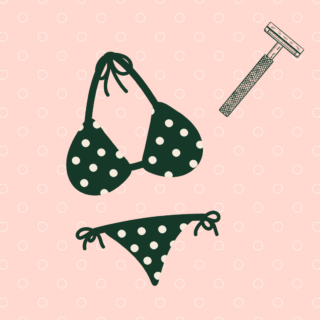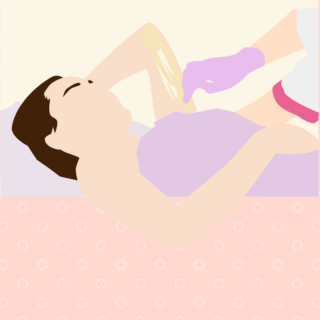
Let’s talk hair down there.
Yes, there!
The Rockland County Times has you covered.
Experts Brianna Brass, a licensed esthetician of more than 10 years and owner of Pearl River’s Velvet Truth Esthetics, and Dr. Tal Sarig-Meth, an assistant professor of obstetrics and gynecology at New York Presbyterian Columbia University, share their advice on how to properly care for the bikini area.
RISKS AND BENEFITS OF HAIR REMOVAL METHODS
Shaving

“Shaving is the most accessible form of hair removal and essentially just cuts the hair down to the level of the skin, leaving the hair bulb in place and unharmed,” Sarig-Meth said. “This makes shaving a very short-lasting solution that requires repetition on a daily basis and sometimes in less than 12 hours.”
It may seem easy, but it’s important to be mindful of the risks.
Shaving can not only lead to skin irritation, but adverse effects such as “ingrown hairs, folliculitis (superficial infections), pseudofolliculitis (razor bumps), and spread of viral skin diseases.”
Brass shared that one teen who sought services with her mother accidentally caused self-injury.
“I did actually have a client that had to have a procedure done by a dermatologist to help with a cyst that she did unfortunately self-induce with shaving,” she said.
Shaving also may not deliver the result that one wishes, leaving a rougher texture to the skin.
“As far as my experience goes, I can attest to people who do have a little bit of more curlier or coarse hair talking about specifically the nether region or the back, it’s going to be a little bit of a difficult shave and they may find themselves grinding against their skin with a razor and pulling against the skin,” Brass said. “In turn, you’re going to create a rough surface, an uneven shave of the hairs and you’re never going to have that visual darkness of the hair completely disappear under the skin because it will still be there.”
Sarig-Meth added that there is a common belief that shaving causes the hair to become thicker, which is untrue.
“The sharp edge that is left from the cutting process creates a rough texture that might feel like thicker hair. The true reason for thickening of hair is hormonal effects over time,” she said.
Waxing

“I am overall just trying to help people save a little time in their day, enhance how they feel about themselves with something as simple as an underarm wax for a busy mom or school teacher who now doesn’t have to shave everyday.” – Brianna Brass, owner of Velvet Truth Esthetics
Unlike shaving, waxing removes hair down to the level of the bulb.
Both Brass and Sarig-Meth agree that it’s cheaper and more effective in contrast to shaving.
“Waxing is relatively cheap and longer lasting than shaving, or depilation of the hair, as it can last up to 6-8 weeks, but still has its own adverse effects,” Sarig-Meth said.
Waxing can lead to thermal and mechanical injuries to the skin and, if not done by a careful and licensed esthetician, can transmit skin diseases.
“A best practice for waxing is you definitely want to make sure that there’s no contraindication,” Brass said.
There are wait time periods for waxing for those who use acne medications or skin-thinning products.
She recommends setting up a pre-consultation with her prior to getting any procedure done, bringing in a list of the medications that one uses.
It’s no secret that waxing is more painful and uncomfortable.
“The way that I run my services, be it an eyebrow, an upper lip, an underarm, a brazilian, a back, I’m going to coach you through it,” Brass said. “Now as the caviat for those super intimate areas, we are not going to continue the service if you’re uncomfortable or if I feel your safety is in question because you’re not able to control and hold the pose. I am going to stop the service if you’re crying.”
Waxing is not where it ends.
Brass educates clients on proper aftercare and recommends products for exfoliating, maintaining, hydrating and nourishing the skin.
Laser hair removal
Sarig-Meth described this process as selectively targeting the color component in hair, melanin, and destroying “only the hair within the hair bulb.”
“Theoretically this should cause permanent hair removal, but unfortunately it is not perfect, and it does not alway result in complete and permanent hair removal,” she said.
Adjacent tissue within the skin also absorbs some of the laser energy.
Sarig-Meth said that this reduces the effectiveness, thus leading to the need of multiple treatments in order to achieve the desired effect.
“The growth cycle of the hair follicle also plays a role in the need for multiple treatments as the hair is only sensitive to the laser energy at a certain time of the cycle, and not all hair follicles are in sync with one another,” she said.
Although uncommon, it can also lead to adverse effects such as skin pigmentation and thermal injuries.
Not to mention, this is the most expensive hair removal process.
Forbes reported that laser hair procedures can range anywhere from $100-$800 with the bikini area ranging between $250-$350.

“Due to the different costs and adverse effects of the different methods, it can also cause inequality among people in access and ability to use their desired method, and thus lead to a bigger gap among people from different socioeconomic status. ” – Dr. Tal Sarig-Meth, Assistant Professor of Obstetrics and Gynecology at New York Presbyterian Columbia University
A note for those who are pregnant
“Pregnant women are more prone for skin irritation and pigmentation due to the significant hormonal changes in the body,” Sair-Meth said.
She advises to be mindful of the method they choose as there is a potential higher risk for adverse effects and that methods “might not respond similarly that might have worked for them prior to pregnancy.”
“In addition, the anatomical changes of pregnancy can also lead to suboptimal view of the pubic area and thus make self-bikini hair removal very challenging if even possible to be done safely,” she added.
Which method is best?
Each method has its risks and benefits, but it depends on each individual.
“Some women are more prone to skin irritations and some are more prone to skin pigmentations, and thus it is impossible to generalize the best overall method for hair removal,” she said.
Sarig-Meth suggests that when it comes to safety, try using “hair clippers that are designed to fit the anatomy of the pubic area” as it’s probably the safest and affordable method due to its “minimal effect or contact with the skin and thus least likely to cause any local skin effects.”
The downside of hair clippers is that it’s a short-term solution.
The benefits of letting it be
As a matter of fact, Sarig-Meth shared that there are many theories as to the functions of pubic hair such as skin protection and “entrapment of pheromones in order to attract potential mates.”
Thirdly, you stay clear of any adverse effects of the methods listed above.
Those with fame have no shame and you shouldn’t either
“Everyone in the world is going to have something that they’re not too fond of about themselves. The crazy thing is we’re our own worst harshest critic.” – Brianna Brass, owner of Velvet Truth Esthetics

Many celebrities are not shy when it comes to embracing their body hair.
Emma Watson shared with “Into The Gloss” how she conditions her pubic hair.
“There’s still so much shame around the things you do to get ready while you’ve got a towel wrapped around your head. It’s important to me not to edit that out,” she said.
Be sure to follow @cait_malilay_writes for future articles.
You can also email her at type.away.cait@gmail.com for news tips or stories.

You must be logged in to post a comment Login